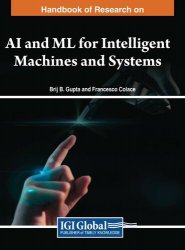Handbook of Research on AI and ML for Intelligent Machines and Systems
- Добавил: literator
- Дата: 22-12-2023, 06:16
- Комментариев: 0
 Название: Handbook of Research on AI and ML for Intelligent Machines and Systems
Название: Handbook of Research on AI and ML for Intelligent Machines and SystemsАвтор: Brij B. Gupta, Francesco Colace
Издательство: IGI Global
Год: 2024
Страниц: 530
Язык: английский
Формат: pdf (true), epub
Размер: 33.6 MB
The Handbook of Research on AI and ML for Intelligent Machines and Systems offers a comprehensive exploration of the pivotal role played by Artificial Intelligence (AI) and Machine Learning (ML) technologies in the development of intelligent machines. As the demand for intelligent machines continues to rise across various sectors, understanding the integration of these advanced technologies becomes paramount. While AI and ML have individually showcased their capabilities in developing robust intelligent machine systems and services, their fusion holds the key to propelling intelligent machines to a new realm of transformation. By compiling recent advancements in intelligent machines that rely on machine learning and deep learning technologies, this book serves as a vital resource for researchers, graduate students, PhD scholars, faculty members, scientists, and software developers. It offers valuable insights into the key concepts of AI and ML, covering essential security aspects, current trends, and often overlooked perspectives that are crucial for achieving comprehensive understanding. It not only explores the theoretical foundations of AI and ML but also provides guidance on applying these techniques to solve real-world problems. Unlike traditional texts, it offers flexibility through its distinctive module-based structure, allowing readers to follow their own learning paths.
Measuring Throughput and Latency of Machine Learning Techniques for Intrusion Detection: When evaluating the effectiveness of Machine Learning algorithms for intrusion detection, it is insufficient to only focus on their performance metrics. One must also focus on the overhead metrics of the models. In this study, the performance accuracy, latency, and throughput of seven supervised Machine Learning algorithms and a proposed ensemble model were measured. The study performs a series of experiments using two recent datasets, and two filter-based feature selection methods were employed. The results show that, on average, the naive bayes achieved the lowest latency, highest throughput, and lowest accuracy on both datasets. The logistics regression had the maximum throughput. The proposed ensemble method recorded the highest latency for both feature selection methods. Overall, the Spearman feature selection technique increased throughput for almost all the models, whereas the Pearson feature selection approach maximized performance accuracies for both datasets.
A Study on AI and Blockchain-Powered Smart Parking Models for Urban Mobility: Urban problems like traffic jams and a lack of parking spaces can be solved in an innovative way with the help of smart parking models powered by AI and blockchain technology. These models enhance user experience, optimise space allocation, and shorten search times. Predictive analytics and real-time data from IoT sensors direct drivers to available parking spaces, minimising traffic and environmental impact. By protecting user privacy, controlling access, and securing transactions, blockchain technology improves AI. Users are empowered by blockchain-based decentralised digital identities, which also guarantee data privacy and transparent business dealings. With less traffic, more user happiness, and significant cost savings, this combination produces user-centric, environmentally friendly, and cost-effective smart parking solutions. The cost-benefit analysis for AI and blockchain-powered smart parking demonstrates a favourable return on investment, paving the way for smarter, greener cities and more interconnected urban settings.
Machine Learning and Deep Learning for Intelligent Systems in Small Aircraft Applications: This chapter explores the integration of machine learning and deep learning techniques in small aircraft applications. The aviation industry is exploring innovative solutions to improve safety, efficiency, and performance in these operations. The chapter explores the advantages, challenges, and future prospects of implementing intelligent systems in small aircraft, including autopilot systems, navigation assistance, fault detection, and pilot support systems. Real-world case studies and applications demonstrate the transformative impact of these technologies on small aircraft operations. The chapter provides a comprehensive overview of the latest advancements in Machine Learning and Deep Learning, highlighting their pivotal role in improving small aircraft intelligence, safety, and efficiency.
Скачать Handbook of Research on AI and ML for Intelligent Machines and Systems
Внимание
Уважаемый посетитель, Вы зашли на сайт как незарегистрированный пользователь.
Мы рекомендуем Вам зарегистрироваться либо войти на сайт под своим именем.
Уважаемый посетитель, Вы зашли на сайт как незарегистрированный пользователь.
Мы рекомендуем Вам зарегистрироваться либо войти на сайт под своим именем.
Информация
Посетители, находящиеся в группе Гости, не могут оставлять комментарии к данной публикации.
Посетители, находящиеся в группе Гости, не могут оставлять комментарии к данной публикации.
